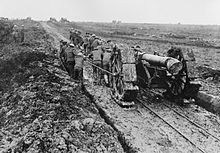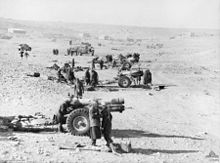BL 6-inch 26 cwt howitzer
| BL 6 inch 26 cwt Howitzer | |
|---|---|
 A 6 inch 26 cwt on World War II pneumatic tyres at the Royal Artillery Museum. | |
| Type | Medium howitzer |
| Place of origin | United Kingdom |
| Service history | |
| In service | 1916 to 1945 |
| Used by | United Kingdom Canada Union of South Africa Australia New Zealand Italy Netherlands Belgium Greece Russian Empire Portugal Estonian Republic |
| Wars | World War I World War II |
| Production history | |
| Designer | Vickers |
| Designed | 1915 |
| Manufacturer | Vickers, Beardmore, Coventry Ordnance Works, Woolwich Ordnance Factory, Midvale Steel Company |
| Produced | 1915 - ? |
| No. built | 3,633 |
| Specifications | |
| Mass | Barrel: 2,856 lb (1,295 kg) Total: 8,142 lb (3,693 kg)[1] |
| Length | 21 ft 7 in (6.58 m) |
| Barrel length | Bore: 6 ft 8 in (2.03 m) Total: 7 ft 3 in (2.21 m) L/13.3 |
| Width | 6 ft 10 in (2.08 m) |
| Crew | 10 |
| Shell | Gas Incendiary High explosive |
| Shell weight | WWI: 100 pounds (45.4 kg) WWII: 86 pounds (39.0 kg) |
| Calibre | 6 in (152.4 mm) |
| Breech | Welin screw |
| Recoil | Hydro-pneumatic, variable |
| Carriage | Box trail |
| Elevation | 0° to +45° |
| Traverse | 4° L & R |
| Rate of fire | Max: 2 rpm |
| Muzzle velocity | Max: 1,400 ft/s (430 m/s) |
| Maximum firing range | WWI 100 pounds (45.4 kg) shell : 9,500 yards (8,700 m) WWII 86 pounds (39.0 kg) shell : 11,400 yards (10,400 m)[2] |
| Sights | Calibrating (1930s) & reciprocating |
The Ordnance BL 6 inch 26cwt howitzer was a British howitzer used during World War I and World War II. The qualifier "26cwt" refers to the weight of the barrel and breech together which weighed 26 long hundredweight (1.3 t).
History[edit]
World War I[edit]



It was developed to replace the obsolescent 6 inch 25 cwt and 6 inch 30 cwt howitzers which were outclassed by German artillery such as the 15 cm schwere Feldhaubitze 13. Design began in January 1915, the first proof-firing occurred on 30 July 1915 and it entered service in late 1915.[1] Its combination of firepower, range and mobility (for its day) made it one of the British Empire's most important weapons in World War I.
It was originally towed by horses but from 1916 onwards was commonly towed by the FWD 4 wheel drive 3 ton lorry as heavy field artillery. The wooden spoked wheels could be fitted with "girdles" for work in mud or sand to prevent them sinking. Towards the end of the war solid rubber tyres were fitted over the iron tyres on the wheel rims, giving the rims a heavier appearance. It fired 22.4 million rounds on the Western Front.[3]
World War II[edit]

During the interwar period the carriage had its wooden spoked wheels replaced with modern steel wheels and pneumatic tyres. During World War II, its use was restricted after 1942 when the replacement BL 5.5 inch Medium Gun came into use but it was reintroduced in Burma due to a number of premature detonations in 5.5-inch (140 mm) guns. It was declared obsolete with the end of the war in 1945.
Captured examples received the designation FH-412(e) in German use.
Surviving examples[edit]

- Royal Artillery Museum, Woolwich, London Archived 26 April 2016 at the Wayback Machine
- Army Memorial Museum, Waiouru, New Zealand
- Royal Australian Artillery Museum, North Head, Sydney, Australia
- Museo della guerra (War Museum), Rovereto (Italy)
- South Africa : The Imperial Government presented 6 howitzers to the Union of South Africa after World War I and the six South African Heavy Artillery Memorials were designed, commissioned and paid for by the South African Heavy Artillery Association to honour their fallen Comrades-in-Arms : Memorial to 71st (Transvaal) Siege Battery at Johannesburg Zoo (restored); 72nd (Griqualand West) Siege Battery at Clyde N Terry Museum, Kimberley; 73rd (Cape) Siege Battery at Company Gardens, Cape Town; 74th (Eastern Province) Siege Battery at National Museum, Bloemfontein (Restoration is about to begin, May 2009); 75th (Natal) Siege Battery, Warriors' Gate MOTH Shellhole, Old Fort Road, Durban; 125th (Transvaal) Siege Battery near the Union Buildings, Pretoria.
These guns are being restored by the Gunner's Association of South Africa
- National Museum of Military History, Saxonwold, Johannesburg, South Africa
- The Central Museum of The Royal Regiment of Canadian Artillery, Shilo Manitoba
- Barracks Green Armouries, Belonging to and restored by 3rd Field Regt.(The Loyal Company), Saint John, New Brunswick
World War I ammunition[edit]
Projectiles used in World War I weighed 100 pounds (45.4 kg). A lighter 86 pounds (39.0 kg) long-range projectile was introduced in November 1918, too late to see service in the war [3]
-
Common pointed 100lb shell Mark XIIA
-
100lb chemical shell Mark VIII
-
High explosive 100lb shell Mark XVI
See also[edit]
- BL 6 inch 30 cwt howitzer : British predecessor
- List of howitzers
Weapons of comparable role, performance and era[edit]
- Canon de 155 C modèle 1917 Schneider French equivalent
- 15 cm sFH 13 German equivalent
- 152 mm howitzer M1910 Russian equivalent
Notes and references[edit]
- ^ a b Hogg & Thurston 1972, Page 126-127
- ^ Clarke page 37 quotes 9,500 and 11,400 yd (10,400 m); General Farndale page 129-130 quotes a range of 9,800 yd (9,000 m) for the WWI 2 c.r.h. shell, with a range of 12,500 yd (11,400 m) for the later 5/10 c.r.h. shell. The longer ranges were obtained with the 86 lb (39 kg) Mk 2D 5/10 c.r.h. shell with an augmenting ("Super") charge.
- ^ a b Clarke 2005, page 37
Bibliography[edit]
- Dale Clarke, British Artillery 1914-1919. Heavy Artillery. Osprey Publishing, Oxford UK, 2005 ISBN 978-1-84176-788-8
- General Sir Martin Farndale, History of the Royal Regiment of Artillery. Western Front 1914-18. London: Royal Artillery Institution, 1986. ISBN 978-1-870114-00-4
- I.V. Hogg & L.F. Thurston, British Artillery Weapons & Ammunition 1914-1918. London: Ian Allan, 1972. ISBN 978-0-7110-0381-1
External links[edit]
- Handbook of the B.L. 6-inch 26-cwt. Mark I howitzer on Mark I travelling carriage, (land service), 1919. Hosted online by State Library of Victoria, Australia
- Gun drill for 6-inch B.L. 26-cwt howitzer Mark I carriage Mark I 1920 Hosted online by State Library of Victoria, Australia
- Gun drill for B.L. 6-inch 26 cwt howitzer Mark 1 carriage Mark 1 1926 Hosted online by State Library of Victoria, Australia
- War Office (1916). "Chapperton Down Artillery School [film]". IWM Film. Imperial War Museum. 10:01:02:00. Retrieved 11 February 2019.
- Video clips on YouTube
- Nigel F Evans, British Artillery in World War 2. 6-Inch Howitzer
- W L Ruffell, BL 6-in 26-cwt howitzer
- 6 inch 26 cwt Howitzer at Landships
- Walk around BL 6-inch 26-cwt howitzer WWI exposed to the Sacrario Militare di Redipuglia / Italy




